Bringing cypress to the fore
Rachel Rose, New Zealand Tree Grower August 2020.
This article adds a lot more detail to the article on the Cypress Development Group weekend which was in the May Tree Grower.
The future of cypress in New Zealand is golden if the turnout at the Cypress Development Group’s event last summer is any indicator. Over 80 people attended from around the country for the three-day event. It spanned discussion on genetics, disease pressure, planting and management regimes, assessment of different species, the supply chain, the end-uses of cypress and marketing.
Also notable was the breadth of representation which included plant breeders, researchers, former and current leaders of government departments and Crown Research Institutes, nurserymen, forest owners, contractors, sawmillers and timber merchants. That made for robust discussion and a diversity of perspectives. Having everyone involved is important because confidence in cypress needs boosting. Or more accurately, there are reasons to confidently plant cypress again and those reasons need to be widely shared.
Some cypress background
We have some history we need to acknowledge and move on from. Many people lost entire stands of timber planted in the 1990s after their macrocarpa got wiped out by cypress canker. Who can blame small-scale forest owners for replanting with radiata pine?
It is easy in hindsight to see that cypress clones suck as kukupa were released too early and without sufficient testing. After some years in the wilderness, cypress made their way back into research trials. There are now provenances of macrocarpa which are either canker-tolerant, meaning trees are not badly affected and their growth is not checked, or canker-resistant where it appears they do not get infected even when the fungal spores are present.
Meanwhile, other cypress with similar qualities have been trialled on New Zealand sites. These include C. lusitanica Mexican cypress, Chamaecyparis lawsoniana Lawson cypress and hybrids Cuprocyparis leylandii Leyland’s cypress and C. ovensii Oven’s cypress. Understandably, growers want to understand more about what buyers are looking for. That is why it was so valuable to have sawmillers and timber merchants present and why we spent much of one day on-site at a sawmill.
What are the best trees?
There was spirited discussion right from the outset about the characteristics of the best trees. This was personified in the whole debate about Harry and Neil, two trees in Don Tantrum’s 28-year old lusitanica stand. Back in the day, Harry Bunn and Neil Barr came through to inspect the forest and each picked the best tree in the stand. They did not agree and the two trees that now bear their names are completely different.
The tree Neil has a short, fat butt-log with a heavy crown while Harry has a taller, thinner butt-log, a top log and much lighter branching. Those assembled could not agree on the better tree any more than Harry and Neil had.
This launched us into the first of many discussions about what sawmillers want. Why are they so coy about what they pay for logs? Some possible answers are −
- There is only a small number of independent sawmillers who specialise in milling alternatives to pine
- There is competition among them for logs and firewood operators are keen to buy farm macrocarpa
- Regional markets with their own characteristics are developing.
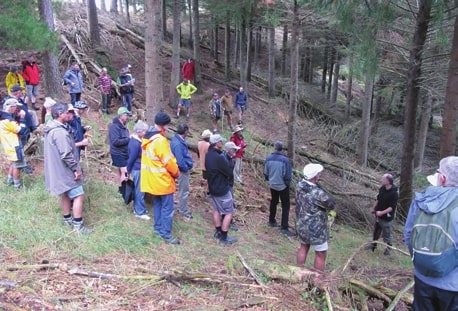
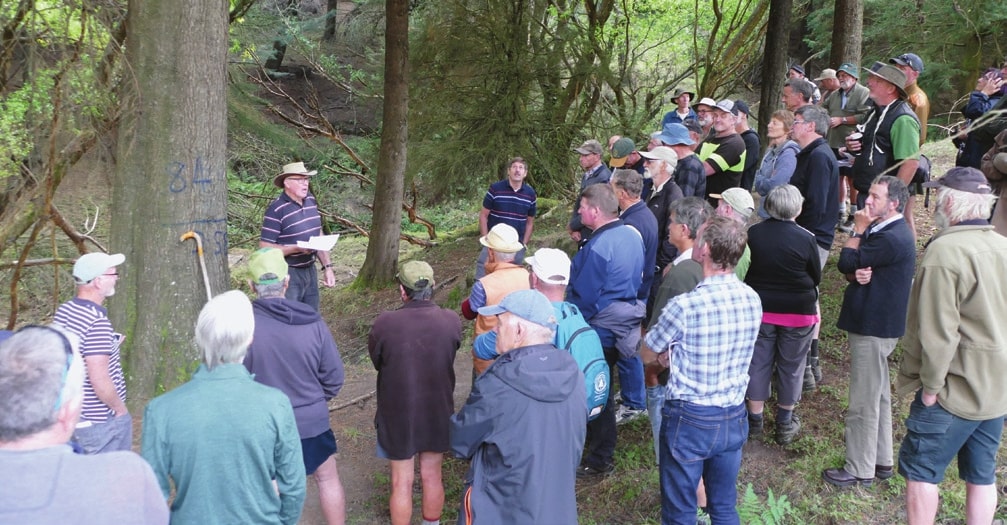
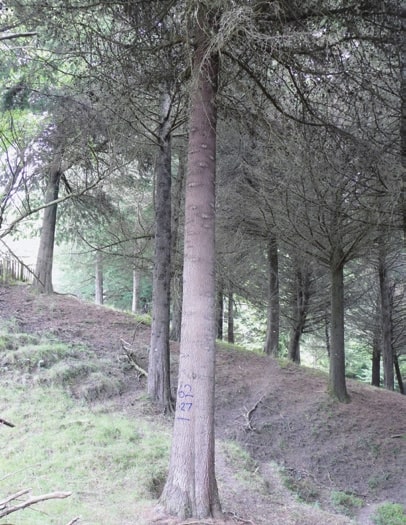
Selling cypress
What impedes the growth of a stable nationwide domestic market for cypress. Is it lack of consistent demand or lack of consistent supply of quality timber? It is chicken-and-egg. Some of those present had far bigger aims for cypress, seeing it as a mainstream alternative to rival radiata pine and wanting to see big export markets established. That is a longer-term target around which there was some discussion after lunch in Don Tantrum’s woolshed, again focused on marketing.
Is the NZFFA the right organisation to bring cypress into the glorious future it deserves? Or should a dedicated organisation be founded which includes everyone including corporate forest owners? The cypress stands of farm foresters alone will not be big enough to provide a constant supply of specific grades in large volumes to export markets.
Remember the customer
There was also discussion about customer preference for different cypress. Macrocarpa is well known and increasingly sought-after. Customers value the colour of macrocarpa and we heard reports of deliveries of macrocarpa mixed with lusitanica being refused because of the pale hue of the lusitanica. Dean Satchell was adamant that colour is a function of timber age and that both macrocarpa and lusitanica need to be harvested at 50 years, not 40, if the aim is golden-coloured timber.
As an industry we could market all our cypress species under a single cypress banner. The Australians do this under the name ‘golden cypress’. We could emphasis the domestic provenance by selling New Zealand cypress. But there is variety in the appearance and characteristics of the different species – for example, Lawson’s cypress is stiffer and therefore more suited for structural timber than macrocarpa.
Growing regimes
We cannot sell what we have not grown and there was a lot of nitty-gritty discussion about how to grow cypress including stocking rates, hybridisation, choosing clones or seedlings, as well as when and how to thin and prune.
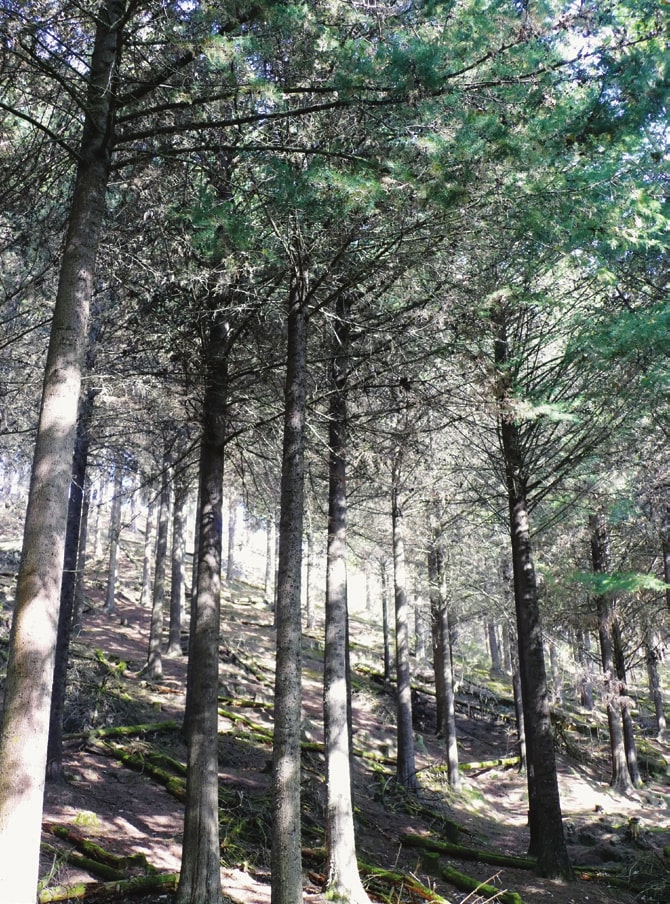
We also visited Bill Parkes’ stand of lusitanica. There was a spirited discussion in the shade of promising trees about how to manage this 16-hectare block planted in the 1990s. All agreed thinning was required. Growth was variable and it was about to stop because of competition. Vaughan Kearns and Kees Weytmans advocated taking out every second row, straight forward and least likely to damage remaining trees. Others called for production thinning. Richard Thompson considered this block was ideally suited for continuous canopy management.
As with the best discussions, this led the conversation into a new direction, about the skills required for production felling. Don Wallace described an arborist’s felling course he had taken in Wellington, surprisingly inexpensive and very relevant to the needs of a farm forester. Others were adamant that felling was not work that we, as forest owners, should be doing ourselves. It is too risky and we should be bringing in professionals.
However, where are the professionals to hire? Labour shortages were noted, and the general difficulty of getting contractors of into smaller blocks and especially stands that were not radiata. How could we as a group improve this situation? Would it be viable for small, independent contractors with allied skills to improve their skills in tree felling and provide a local service?
Cypress among the redwoods
The day concluded at the New Zealand Redwood Company’s block at Okota. It was inevitable that conversation would extend to redwoods, given we were among lovely specimens. But on the hillside above, a site considered unsuitable for redwoods, stood stands of three cypress namely ovensii, lusitanica and macrocarpa.
The macrocarpa were an interesting case in point. They were planted at three by three metre spacing before Simon Rapley joined the Redwood Company. He expected they would be ruined by canker and decided not to prune, assuming it would be a waste of money. The trees confounded expectation and are quite healthy. There was considerable discussion about how to tackle pruning and thinning a congested stand like this and what equipment to use. Chemical thinning was ruled out.
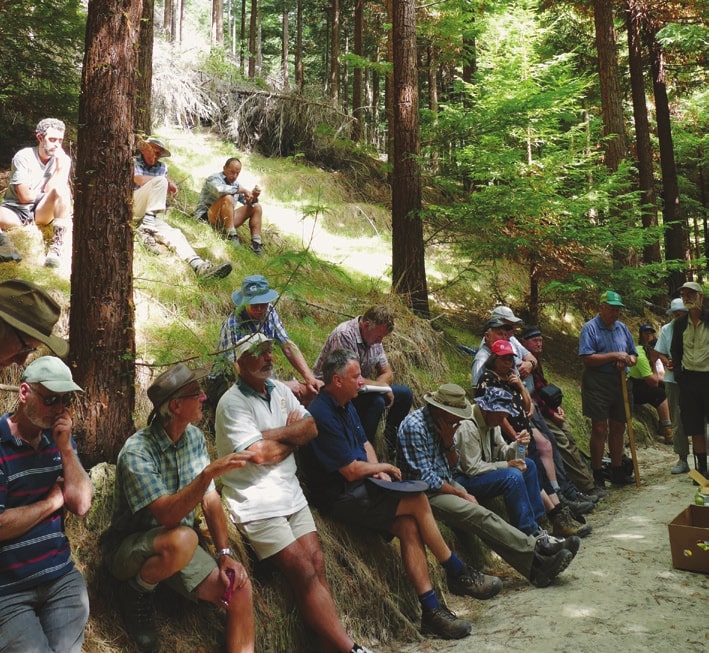
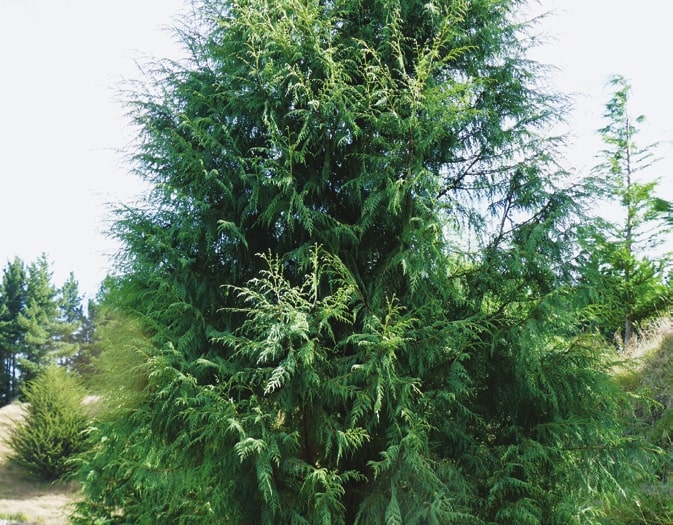
New cypress kids on the block
Seeing the experimental planting of Himalayan cypress, C. torulosa, on steep hills above Ruapehu Sawmills was a highlight of the weekend. This is a revered timber in its homeland, durable and resistant to canker. It is slow-growing in its natural environment but expectations are high that it will grow considerably faster in New Zealand conditions. The trial was established by Dean Satchell. He wanted an extreme site to test two distinctly different provenances of this promising species and drought, wind, frost, even snow is all available here.
Torulosa is a good-looking tree, with a narrow conical shape and fine foliage. A seedling trial was established from a Northland source and from this, four selections have been made. Each bears the name of the man who chose it and are appealing in distinct ways. The way Vaughan tells it −
- Dean went for the tallest tree and one with the largest diameter at breast height.
- The pick by George Shallcrass was not as big, but the stem was very straight, with very fine branching.
These two choices are reminiscent of the Harry and Neil selection at Don Tantrum’s.
- Angus Gordon opted for one in between, looking for the best of both worlds.
- Vaughan chose from what was left and selected a tree which had reasonable attributes but whose growth was keeping up despite growing on a much harder site.
Cuttings from these selected trees have been harvested and shipped to Patrick Milnes’ nursery for propagation. The Cypress Development Group hopes to have trees available for sale next season. Patrick and Vaughan both want to establish stool beds which will bulk up propagation.
Making the most of the log
If you have trees in the ground, it is worth knowing what happens after they are felled. It is no surprise that the forest growers in attendance at the field day were interested in the sawmillers’ investment in a range of equipment and how they are developing different strategies to extract the most, and best, out of any log.
The more the miller can extract, the greater the value in the domestic market. This should flow back to growers in the form of better log prices. Knowing what is important in the market can also be valuable when it comes to decisions about which alternative species to plant, along with provenance, stocking rates, pruning and thinning regimes.
The May Tree Grower article about these field days gave us some information about the mills Vaughan Kearns showed us, but here is a little more detail about how they are used. Vaughan’s fifth sawmill arrived the day we visited, a very portable Peterson swingblade. He has so many mills because each has advantages and disadvantages. Multiple mills mean any log can be directed to the equipment which can get the most value out of it.
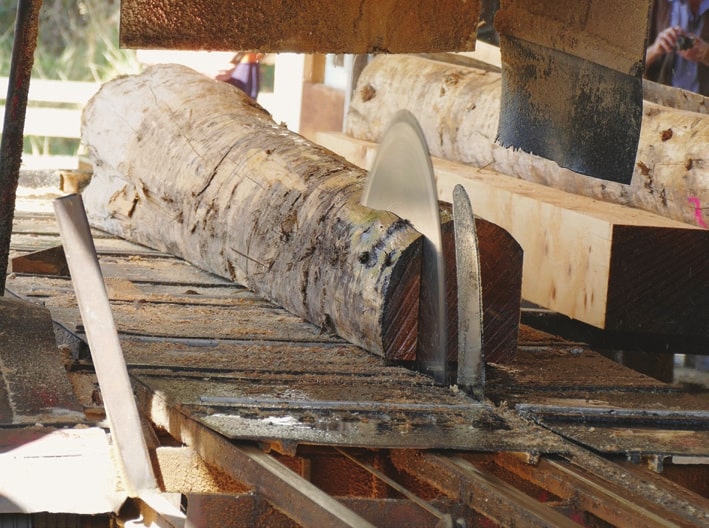
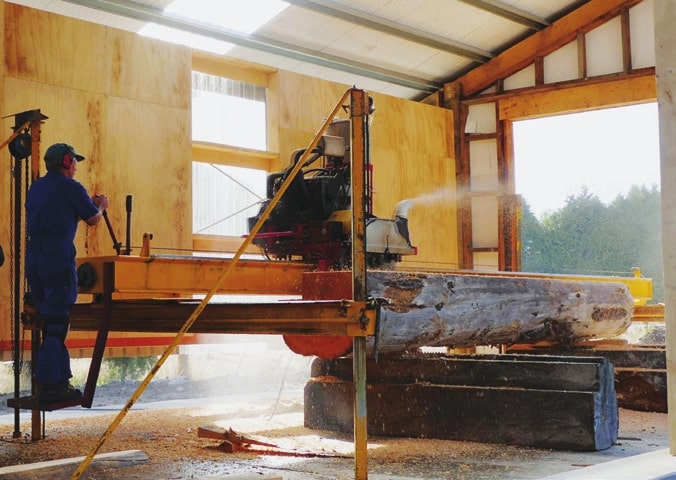
The oldest first
The oldest sawmill is a 1948 Varteg, a large circular saw which is ideal for logs with defects such as being bent, with areas of rot or having dirt on them. However, its electric motor uses a lot of power, it is extremely noisy and the seven millimetre thick blade reduces recovery rates − more sawdust means fewer boards. It is often used in conjunction with an older Woodmizer an LT40 which is in the same shed. The Varteg will clean up defects and the clean wood will be moved on to the Woodmizer for further processing.
A new bandsaw sits in the middle of the site, a Woodmizer LT70. It has more hydraulics than the LT40, and these load and turn a log on to the saw bench.
The bandsaw blade is quite thin, so recovery rates are higher than the thicker circular saw or swing blade, and it produces a finer finish. It is fully automated so is less physically demanding for the operator. The downside is that it takes longer to learn how to use it and it is much slower compared to the other mills.
The Mahoe mill is a recent acquisition and the engine and saw blades have been modified by its former owner. It is a high production mill suited to good-shaped logs. It is also the only option for the really big logs. The Varteg and the Woodmizer cannot handle logs more than 900 mm in diameter.
The newer Woodmizer is set up with a twin-blade edger behind, so that boards can be straightened right as they come off the saw. This is a valuable technique for improving recovery from alternative species.
Thanks are owed to all those who hosted us, the team which organised the event and associated activities such as collecting propagating material, and especially to Vaughan who did the heavy lifting by organising the event programme and the logistics. The feedback from participants was excellent. Given the necessity of cancelling the 2020 NZFFA conference due to Covid-19, it was fortunate that so many farm foresters had the opportunity to meet up at this event.
Rachel Rose is an enthusiastic member of the Middle Districts branch.

 Farm Forestry New Zealand
Farm Forestry New Zealand